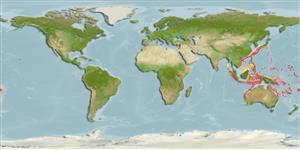Teleostei (teleosts) >
Acanthuriformes (Surgeonfishes) >
Antigoniidae (Deepbody boarfishes)
Etymology: Antigonia: Daughter of Oedipus and Jocasta, who defied her uncle, king Creon, by performing funeral rites over her brother Polynices and was condemned to be immured in a cave (Ref. 45335).
Eponymy: Lowe did not explain his reason for coining this name, but presumably it is derived from mythology as FISHBASE suggests: Antigone was the daughter of Oedipus and Jocasta, who defied her uncle, King Creon, by performing funeral rites over her brother [...] (Ref. 128868), visit book page.
More on author: Weber.
Environment: milieu / climate zone / depth range / distribution range
Ecology
Marine; demersal; depth range 165 - 304 m (Ref. 58018). Deep-water
Indo-West Pacific: Indonesia and northwestern Australia.
Size / Weight / Age
Maturity: Lm ? range ? - ? cm
Max length : 6.7 cm SL male/unsexed; (Ref. 44983)
Found on the continental shelf and slope (Ref. 7300, 75154). Benthic species (Ref. 75154).
Life cycle and mating behavior
Maturity | Reproduction | Spawning | Eggs | Fecundity | Larvae
Paxton, J.R., D.F. Hoese, G.R. Allen and J.E. Hanley, 1989. Pisces. Petromyzontidae to Carangidae. Zoological Catalogue of Australia, Vol. 7. Australian Government Publishing Service, Canberra, 665 p. (Ref. 7300)
IUCN Red List Status (Ref. 130435: Version 2024-1)
Threat to humans
Harmless
Human uses
Tools
Special reports
Download XML
Internet sources
Estimates based on models
Preferred temperature (Ref.
123201): 12.7 - 21.1, mean 15.5 °C (based on 67 cells).
Phylogenetic diversity index (Ref.
82804): PD
50 = 0.5000 [Uniqueness, from 0.5 = low to 2.0 = high].
Bayesian length-weight: a=0.02188 (0.01034 - 0.04628), b=3.00 (2.81 - 3.19), in cm total length, based on LWR estimates for this (Sub)family-body shape (Ref.
93245).
Trophic level (Ref.
69278): 2.9 ±0.3 se; based on size and trophs of closest relatives
Fishing Vulnerability (Ref.
59153): Low vulnerability (10 of 100).
